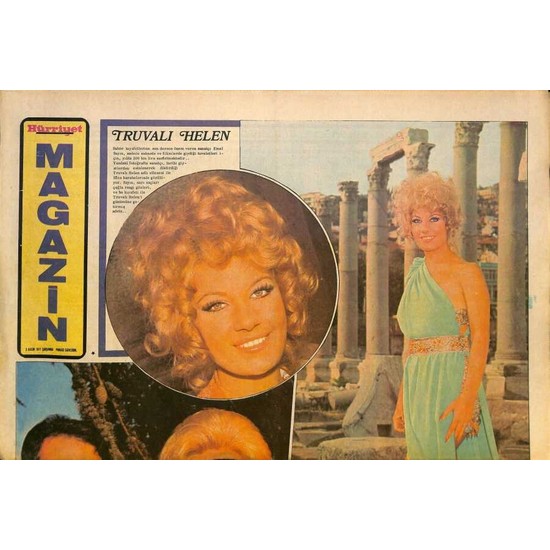The Goldbergs: Comparing The Show To Real-Life 80s Families

Table of Contents
Family Dynamics: The Goldberg Family vs. The Average 80s Household
The Goldberg family, with its boisterous patriarch, overbearing matriarch, and three wildly different children, offers a fascinating lens through which to examine typical 80s family structures. While exaggerated for comedic effect, many aspects resonate with those who lived through the decade.
Parental Roles: Murray Goldberg and the Average 80s Dad
Murray Goldberg, the gruff but ultimately loving father, embodies a common archetype of the 80s dad. Many fathers of that era prioritized their roles as providers, often exhibiting a more emotionally reserved demeanor than today's fathers.
- Strict discipline: Murray's firm hand wasn't unusual. Many 80s parents employed stricter disciplinary methods than are common now.
- Emotional unavailability: While loving, Murray's struggles with expressing affection were common among men of his generation. Open displays of emotion weren't always the norm.
- Provider role: Murray's dedication to providing for his family mirrors the societal expectation placed on many 80s fathers as the primary breadwinners.
- Generational differences: The show highlights the generational gap between Murray and his children, reflecting the changing social landscape of the 80s.
The changing roles of mothers and fathers are subtly explored. Beverly Goldberg, while sometimes overbearing, actively participates in her children's lives, showcasing the evolving expectations for mothers in the workforce and at home.
Sibling Rivalry: The Goldberg Siblings and Their 80s Counterparts
The Goldberg siblings – Adam, Barry, and Erica – showcase the classic dynamics of sibling rivalry. Their constant bickering, competition for attention, and occasional moments of support resonate deeply with anyone who grew up with brothers and sisters.
- Competition for attention: The struggle for parental approval and limited resources is a universal experience, amplified in The Goldbergs for comedic effect.
- Shared bedrooms: The cramped quarters and sibling squabbles over space are a relatable 80s experience for many families.
- Teasing: The constant teasing and playful (and sometimes not-so-playful) ribbing among the siblings accurately reflect the dynamics of many 80s households.
- Occasional support: Despite their disagreements, the siblings ultimately show loyalty and support for one another.
The show effectively captures the intense bond and sometimes contentious relationships typical of families sharing a home and competing for resources in the 80s.
Extended Family Influence: The Goldberg Clan and Multi-Generational Households
The Goldbergs showcases the significant influence of extended family, a common feature of many 80s families. While not explicitly shown all the time, the presence of grandparents and other relatives plays a role in shaping the family's values and traditions.
- Multi-generational households: While not a central theme, the occasional appearances of extended family members subtly highlight the prevalence of multi-generational living arrangements in some 80s families.
- Family gatherings: The show portrays family dinners and celebrations as important events, underscoring the centrality of family time.
- Support networks: Extended family often provided a crucial support system, especially for childcare or financial assistance.
- Cultural influences: Family traditions and cultural practices were passed down through generations, often influencing the upbringing of children.
The show accurately reflects the vital role extended family played in the lives of many 80s families, offering a support network and a sense of community.
Cultural Touchstones: Accurately Depicted 80s Nostalgia
The Goldbergs excels in its detailed and nostalgic portrayal of 1980s culture. The show’s creative use of period-specific references enhances its relatability and comedic appeal.
Popular Culture References: Music, Movies, TV, and Fashion
The show masterfully incorporates 80s pop culture references, evoking a sense of nostalgia for those who lived through the era and introducing it to younger audiences.
- Music: From iconic songs by artists like Bon Jovi and Cyndi Lauper to the sounds of synthesizers and power ballads, The Goldbergs expertly uses music to set the scene and evoke the decade.
- Movies: The show subtly (and sometimes overtly) references popular movies of the time, from blockbuster hits to cult classics.
- TV shows: The characters often watch and discuss popular TV shows of the 80s, giving a glimpse into the television landscape of the time.
- Fashion: Big hair, leg warmers, and neon colors are just some of the 80s fashion trends highlighted in the show.
These references create a vibrant and recognizable depiction of the 80s cultural landscape.
Technological Advancements: Computers, Video Games, and More
The Goldbergs showcases the technological advancements of the 80s, highlighting the impact of these changes on family life.
- Home computers: The introduction of home computers like the Commodore 64 and Apple II into the Goldberg household is a hallmark of the technological shifts in the 80s.
- Video games: Atari and Nintendo systems become focal points of family entertainment, accurately reflecting the rising popularity of video games in the decade.
- VCRs: The use of VCRs for recording TV shows and watching movies significantly shaped family entertainment in the 80s.
- Camcorders: The use of camcorders for capturing family memories is another element that reflects the changing technological landscape.
The show’s depiction of these technological changes provides valuable insight into how technology affected family life and entertainment in the 1980s.
Social and Political Climate: Subtle and Overt References to the Era
While primarily a sitcom, The Goldbergs occasionally touches upon the social and political climate of the 1980s.
- The Cold War: The constant threat of nuclear war and the tense relations between the US and the Soviet Union are subtly reflected in some episodes.
- Reagan era politics: The political landscape of the Reagan years subtly influences some of the show's storylines.
- Social movements: The show acknowledges, though doesn’t heavily feature, some of the significant social movements of the time, such as the rise of feminism and LGBTQ+ rights movements.
- Economic conditions: The show reflects the economic realities of the 80s, touching on issues like economic prosperity and the resulting consumerism.
The show’s handling of these sensitive topics is often lighthearted, but it acknowledges the complexities of the 80s social and political climate.
Exaggeration for Comedic Effect: Where The Goldbergs Deviates from Reality
While The Goldbergs offers a largely accurate portrayal of 80s family life, it relies on exaggeration for comedic effect. This is a necessary element of sitcoms, but it's essential to recognize where the show deviates from the reality of the time.
Character Exaggerations: Larger-Than-Life Personalities
The show's characters are often heightened for comedic impact. This isn't necessarily a bad thing; it allows for more humor, but it moves away from realistic portrayals.
- Murray's gruffness: While many 80s fathers were emotionally reserved, Murray's gruffness is taken to an extreme for comedic effect.
- Beverly's overbearing nature: Beverly's overprotective and sometimes suffocating parenting style is significantly amplified compared to the average 80s mother.
- The children's eccentricities: The Goldberg children's personalities are exaggerated to create humorous situations.
This exaggeration contributes significantly to the show's humor but sacrifices complete realism.
Plotlines and Situations: Heightened Reality for Comedic Effect
Many plotlines and situations in The Goldbergs are far-fetched and highly improbable compared to average 80s family experiences. However, this is by design.
- Examples: Numerous episodes feature events that would be highly unlikely to happen in real life. These events serve to amplify the comedy and add to the show’s overall comedic tone.
The show strikes a balance between believable scenarios and farcical comedy, effectively creating a humorous and entertaining portrayal of an 80s family.
Conclusion
The Goldbergs, while employing comedic exaggeration, successfully captures the essence of many 80s family dynamics and cultural touchstones. The show’s nostalgic appeal stems from its relatable portrayal of sibling rivalry, parental struggles, and the influence of popular culture. However, it’s crucial to remember the show's primary function is entertainment, and some aspects are significantly amplified for comedic effect. The Goldbergs 80s family serves as a fun and often accurate reflection of the times.
Are you ready to revisit (or discover) the hilarious and heartwarming world of the Goldbergs 80s family? Share your thoughts on how the show compares to your own 80s family memories in the comments below! Let's discuss the relatable aspects and the exaggerated moments of this beloved sitcom that perfectly captures the spirit of the 1980s.

Featured Posts
-
 New Orleans Jail Escape Sheriff Cancels Reelection Campaign
May 22, 2025
New Orleans Jail Escape Sheriff Cancels Reelection Campaign
May 22, 2025 -
 Israeli Embassy Confirms Identities Of Couple Killed In Dc Shooting
May 22, 2025
Israeli Embassy Confirms Identities Of Couple Killed In Dc Shooting
May 22, 2025 -
 Potential Dexter New Blood Trailer Release Date Unveiled
May 22, 2025
Potential Dexter New Blood Trailer Release Date Unveiled
May 22, 2025 -
 Conquering Todays Wordle March 26 2024 The Solution
May 22, 2025
Conquering Todays Wordle March 26 2024 The Solution
May 22, 2025 -
 Nato Da Tuerkiye Nin Yeni Etkisi Zirveye Ulasan Guec
May 22, 2025
Nato Da Tuerkiye Nin Yeni Etkisi Zirveye Ulasan Guec
May 22, 2025
